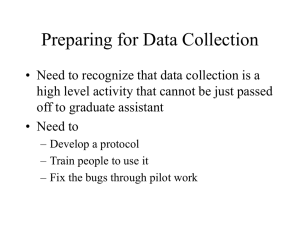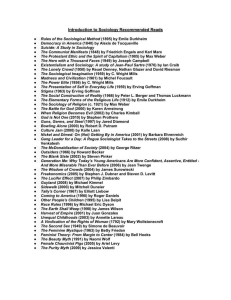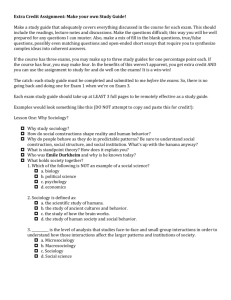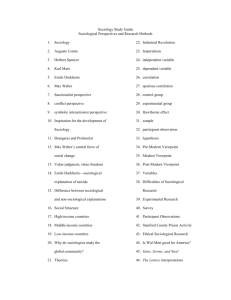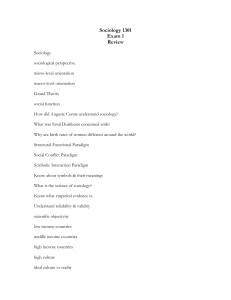Methodology –
advertisement
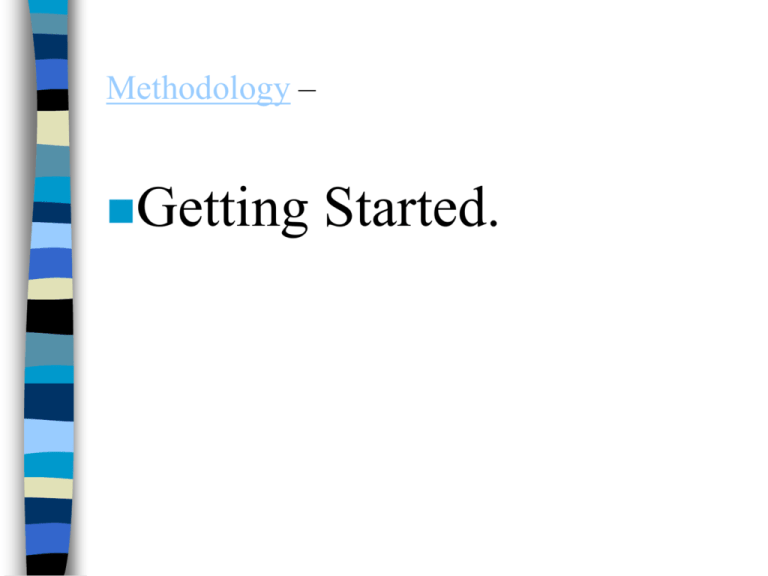
Methodology – Getting Started. Where do you start? Your hypothesis may influence your choice of methodology. Other factors influencing your choice of method(s) are: Time and therefore money. Access to data. Situational constraints – ie the fact that you are but ‘A’ level students. Previous research. Other factors influencing your choice of method(s) are phenomena at hand – it may lend itself to a particular method. ‘The White Haired Offender’Azrini Wahidin that claims: ‘Methods are informed and shaped by the research.’ The Epistemological assumptions. What knowledge is valid? The study of the nature of knowledge. ‘Sociology and Science’ (Sociology Review February 2000) comments on the Positivists approach: ‘Positivists argue that…human behaviour is a response to observable social conditions…that social behaviour is determined and can be explained in terms of cause and effect relationships.’ Epistemological assumptions. Ken Browne However argues …(Interpretavist phonological view): ‘Human behaviour cannot be predicted with certainty. People might react differently to the same circumstance on a different occasion- not everyone facing the same set of circumstance will commit suicide.’ In Sociology Review’s ‘The White Haired Offender’ Azrini Wahidin says: ‘To understand the meaning and motives of social action is the goal of researchers- and this is only possible by using qualitative data.’ Durkheim’s ‘Rules of Sociological Method’ Emile Durkheim’s ‘Rules of Sociological Method’, set out the phenomena to be studied and the ways to study them. Le Suicide, researched the phenomena of suicide. Durkheim’s aim being that he could prove that even the most individualistic action could be correlated to society. Durkheim’s ‘Rules of Sociological Method’ However research was heavily criticised for not interrogating the statistics supplied to him by coroners from around Europe. Do you want to follow Durkheim’s lead by relying on empirical qualitative data? This is not an effective way of researching respondent’s emotions and their subjective view on the issue. Participant Observation An unethical research method? Practical constraints Weber advocated the concept of Verstehen that is where one would attempt to become closely attached to the subjects of study in an attempt to begin to understand how these individuals interpret things that are around him. One develops an “Empathy”. Studies … Humphrey’s ‘Tearoom Trade’ took this type of view on researching homosexuality behaviour. Paul Willis ‘Learning to Labour’ studied a small male group from a school. The problems with this research was gaining entry into the institution, it took six months of discussion with the headmaster before he could gain entry. PO has it advantages and many consider it as true sociology. “As I sat and listened I learnt the answers to the questions that I would not have had the sense to ask.” Participant Observation - Advantages. Social behaviour is in it’s natural setting. Offers the chance for small scale detailed research. Gives validity to the meanings that actors attach to their actions. Constructs the world according to the actor’s norms \ values \ language. It may be used prior to a survey to establish relevant questions. Participant Observation - Disadvantages. Researcher becomes too involved and a poor observer. As the study group is not representative generalisations are not possible. (Bothered?) Recording information is problematic. Is it ethical - Humphreys argued that research is unethical if : – the sociologist misrepresents their identity to gain information. – The sociologist breaks confidence. – The research has negative consequences for those being studied. Participant Observation - Disadvantages. It may be physically dangerous for the observer. It may take a long time to get in, stay in, get out. Can a researcher ever lose their identity and study a group objectively? The observers presence will change group dynamics + therefore behaviour. Structured Interviews Is there the possibility of building up a conversation with the person? In Sociology Reviews article ‘ Which Research Interview’ Andy Hobson claims that: ‘It is much easier (compared to other methods) for researchers/interviewees to get at what they want and ensure that all aspects of the research agenda are covered.’ However Andy Hobson goes on to say: ‘The degree of structure involved might influence the respondents perspective and responses.’ Structured Interviews Another major problem with unstructured (and even structured) interviews is that those responding many not give an accurate or truthful response because they are attempted to impress or please the researcher. This is called the ‘Halo Effect’ and may indeed affect the final results. Andy Hobson comments on the practicalities of interviews: ‘Conduction of interviews can be a time consuming activity, and that…often means that the sample is not sufficiently large to allow generalisations.’ (This may not be a problem if you do not wish to generate scientific laws / macro sociology.) Structured Interviews - Advantages. one can establish a good rapport... honest information can be obtained. people can speak for themselves. meanings behind actor’s actions can be explored - rather than just discovering the facts. A tape recorder can be referred back to at a later date. Structured Interviews - Disadvantages. The success of the interview relies on the skill of the interviewer. Bias - NVC - prompts, follow up certain leads, more than 1 interviewer = different biases. Time consuming + expensive. Samples are small. refusal to be interviewed may skew sample. The questions that you ask will construct the reality you are attempting to investigate. Secondary Data Official Statistics. Mass Media Letters Diaries Previous Research. Official Statistics Only reflect what has been reported to the official agencies e.g., levels of rape \ free school meals. Advantages: Large sample sizes. Information is easily available from the Home Office or other govt dept. Warning when using statistics: political bias + the statistics only reflecting the tips of the iceberg. Pilot Study Wilmot and Young in their study of ‘Family Life in Bethnal Green’ began with a pilot study in order to pick out on certain themes that repeatedly turned up in the questionnaires, as well as gauging whether or the subject was being truthful. Pilot studies eradicate many problems with the questionnaires. (Or other method) The wording of the questions could be interpreted in different ways by the respondent. Respondents may be unwilling to discuss the issues with you. Internet In Sociology Review Volume 4 1997, and article entitled ‘Using the Internet for A’ level sociology discussed how the Internet was an invaluable resource for a sociology student. Ethically - it ensures confidentiality and emotional security. However, due to the detachment of respondent and it would be difficult to determine whether or not all individuals were telling the truth in the information they send. There is of course still the problem of the Halo effect were individuals would perhaps know what kind of one is looking for and thus this may lead them to certain responses. A good internet site is http://freespace.virgin.net/ chris.livesey/rload.htm Triangulation Triangulation can be illustrated by a study entitled ‘Belfast in the 30s: an Oral History (Macdonald and Tipton 1993) they say this on their study: ‘We systematically did a cross-method triangulation, in that every piece of oral evidence that could be, was checked against a range of written sources.’ Triangulation Furthermore Derran (1970) saw triangulation as a way of assessing the validity and reliability of research and the data and information it highlights. Triangulation Bremen continued to highlight ways in which triangulation can be useful. Firstly qualitative and quantative data can be compared and checked against one another to reach a confirmed conclusion. Secondly, that each approach can be used together to gain a more in depth complete picture. Triangulation Eileen Barker study of the unification Church (otherwise known as the Moonies) used participant observation, questionnaires along with interviews. She said this as the reasoning of her combining the methods: ‘…See how the movement as a whole was organised and how it influenced the day to day actions and interaction of its members.’ Triangulation - Advantages. It is possible to gain both QUANTITATIVE and QUALITATIVE data. thus overcoming any ideological constraints re: methodology. It is possible to check the reliability of different sources. It is possible to check that your own interpretation is accurate. Triangulation - Disadvantages. It is time consuming. it is costly. some sociologists would argue that some methods are unacceptable from their theoretical perspective. Conclusion? Perhaps the most important part of the research is that there is a capacity for it to be replicated, to validate the information that you collect.
